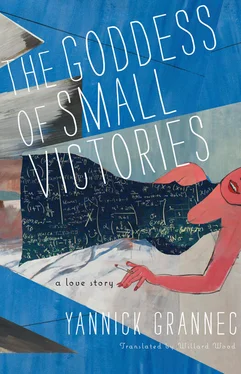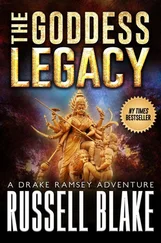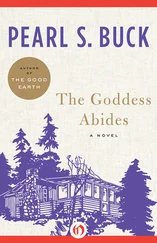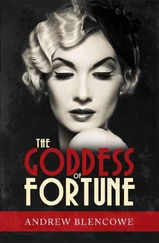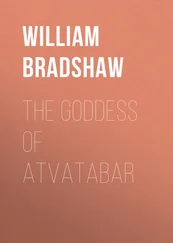Anna Roth; redheaded Anna; Leonard, Calvin, and Virginia Adams; Pierre Sicozzi; Ernestine; Lieesa; Gladys, Jack; Rachel, George; and all the bit players are, however, purely fictional.
1. To oversimplify scandalously: first-order logic is a formal mathematical language using propositions with predicates or variables linked by logical connectives (or operators) such as and, or and if … then . Logic combines “true” and “false” predicates to return a true or false deduction.
2. Adapted from Ninon de Lenclos.
3. In his doctoral dissertation, presented in 1929, Gödel proved the completeness of the first-order predicate calculus. Unlike his later incompleteness theorems, this finding supported Hilbert’s positivist program.
4. Ludwig Wittgenstein (1889–1951), the Vienna-born philosopher and logician, wrote one of the seminal works of twentieth-century philosophy: Tractatus Logico-Philosophicus (1921).
5. In 1942, President Franklin Roosevelt authorized the internment of tens of thousands of American citizens of Japanese, Italian, and German descent. The Alien Registration Act of 1940 required all alien residents of the United States age fourteen years or older to be registered and fingerprinted.
6. “[Mathematics] is given to us in its entirety and does not change — unlike the Milky Way. That part of it of which we have a perfect view seems beautiful, suggesting harmony.” —Kurt Gödel
7. Georg Cantor (1845–1918), the German mathematician, is best known as the inventor of set theory.
8. A function (or “correspondence” between two sets) is bijective if it correlates each element of either set with exactly one element of the other.
9. A quote from David Hilbert.
10. A remark by the German mathematician and logician Leopold Kronecker (1823–1891), who disagreed with Cantor, in the context of hierarchical infinities.
11. John Forbes Nash Jr. (b. 1928) is a mathematician and economist who won the 1994 Nobel Prize in economics for his 1950 dissertation on noncooperative games, a field opened by von Neumann and Morgenstern in 1944 with their Theory of Games and Economic Behavior . Nash suffered from schizophrenia. His story was popularized in the film A Beautiful Mind .
12. Wolfgang Ernst Pauli (1900–1958) won the 1945 Nobel Prize in physics for his formulation of the exclusion principle in quantum mechanics. The principle states that no two fermions (particles like electrons or neutrinos) can be in the same place in the same quantum state.
13. Bertrand Arthur William Russell (1872–1970), mathematician, logician, epistemologist, politician, and moralist, is considered one of the most important philosophers of the twentieth century.
14. Gottfried Wilhelm Leibniz (1646–1716) was a German philosopher, scientist, mathematician, diplomat, and lawyer. He established — in a tiny corner of his gigantic oeuvre — the foundations of integral and differential calculus.
15. John von Neumann (1903–1957) made contributions to many areas of mathematics and physics — quantum mechanics, set theory, hydrodynamics, ballistics — as well as to economics and nuclear strategy. He was one of the fathers of modern computer science. He never won the Nobel Prize. Von Neumann and Robert Oppenheimer were active participants in the Manhattan Project, which developed the first atomic bomb. It was tested on July 16, 1945, in the New Mexico desert. The next two “tests” were over Hiroshima on August 6 and Nagasaki on August 9, 1945. Coincidentally, von Neumann worked before the war as an assistant to the mathematician David Hilbert.
16. Einstein won the Nobel Prize in physics in 1921 for his discovery of the photoelectric effect, not for his work on special or general relativity. He was nominated for the prize in ten of the preceding twelve years.
17. Borrowed from David Hilbert.
18. Fermat’s Last Theorem (as the optimists called it) or Fermat’s Conjecture: for any rational number n larger than 2, there are no positive nonzero rational numbers x, y , and z such that x n + y n= z n . Although mathematicians worked on it for 350 years with mixed results, the theorem was not finally proved until 1995 by Andrew Wiles, a Briton. His proof is frighteningly complex and most certainly does not fit in the margin of any book.
19. In 1946 the average annual salary in the United States was $3,000.
20. At the Los Alamos Laboratory, after the first atomic bomb was detonated, Robert Oppenheimer quoted a passage from the Bhagavad Gita: “Now I am become Death, the destroyer of worlds.” To which Kenneth Bainbridge, who directed the testing, answered, “Now we are all sons of bitches.”
21. Paul Adrien Maurice Dirac (1902–1984) was one of the developers of quantum theory, particularly its mathematical aspects. He predicted the existence of antimatter. With Erwin Schrödinger, he won the Nobel Prize in physics in 1933 “for the discovery of new productive forms of atomic theory.”
22. Hermann Broch (1886–1951), Viennese novelist and essayist, immigrated to the United States shortly after the Anschluss. Thomas Mann (1875–1955), who won the Nobel Prize in literature in 1929, was stripped of his German citizenship by the Nazi government. He moved to Princeton in 1939.
23. After fleeing to Brazil, the Austrian writer Stefan Zweig committed suicide with his wife on February 22, 1942. He dedicated his essay on Freud to Einstein, with whom he was friends.
24. The World of Yesterday , an autobiography, was Stefan Zweig’s last work.
25. In 1946, Albert Einstein became president of the Emergency Committee for Atomic Scientists, whose mission was to inform the public of the dangers of nuclear weapons. The committee was openly against the development of the hydrogen bomb, yet its eight members were all directly or indirectly associated with the Manhattan Project and the making of the first atomic bomb.
26. Einstein underwent surgery in December 1948 for an abdominal aortic aneurysm. Afterward, a famous photograph was taken, in which he sticks out his tongue. He inscribed a newspaper clipping of the photograph to his surgeon: “To Nissen my tummy, the world my tongue.”
27. In 1949, Gödel contributed an article to a collection of essays in honor of Albert Einstein’s seventieth birthday: “A Remark About the Relationship Between Relativity Theory and Idealistic Philosophy.”
28. Years later, his former teacher Hermann Minkowski refined the mathematical foundations of special relativity. Einstein conceded in 1916 that this more “sophisticated” formalization of special relativity had made the discovery of general relativity “much easier.” But this is part of another and extremely complex discussion of the (co)paternity of these theories …
29. In 1992, the physicist Stephen Hawking formulated a “chronology protection conjecture” to exclude these problematic paradoxes. The philosopher and logician Palle Yourgrau described it as an anti-Gödel conjecture.
30. To summarize too briefly: the realist philosophers believe that the external world (and phenomena such as time) exist independently of our minds, our knowledge, and our perceptions, whereas the idealist philosophers do not.
31. The anecdote is supposedly the source of the computer term “bug.” In 1946, ENIAC (Electronic Numerical Integrator and Computer) had a capacity equivalent to 500 FLOPS (Floating-point Operations per Second, a standard measure of the computing ability of a computer). In October 2010, the Tianhe-I, a Chinese supercomputer, achieved calculating speeds of 2.5 petaFLOPS (peta = 10 15). Certain researchers have estimated the computational power of the human brain at between 10 13and 10 19FLOPS. This extrapolation is based on the number of synapses and neuron connectors, but the age of the individual is not taken into account.
Читать дальше
